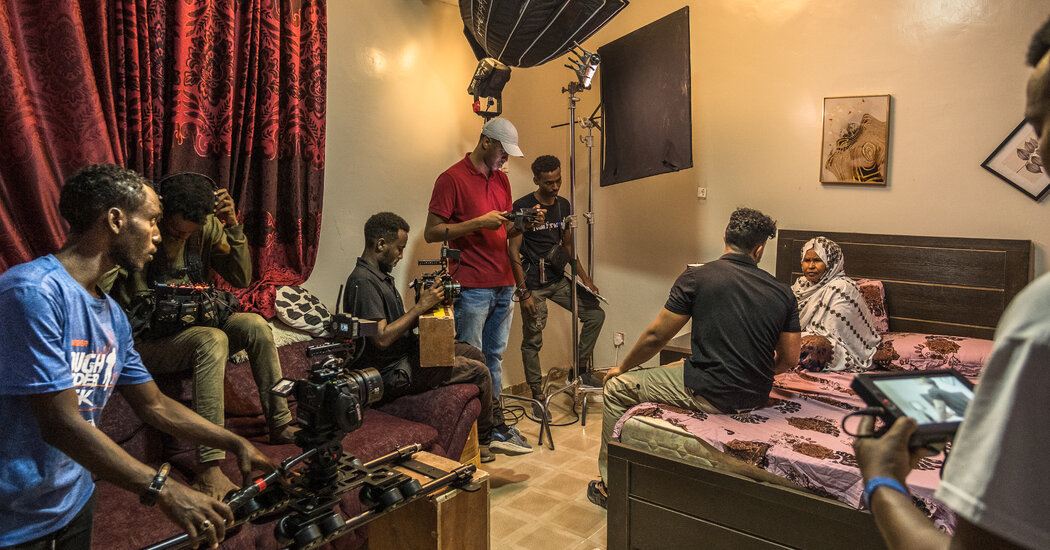
On the cry of “action,” two actors, costumed in lightless blazers and sun shades, erupted right into a spirited shouting fit, gesticulating wildly as one demanded that the alternative persuade his daughter to marry him.
A cameraman and a growth operator, torrid below a sizzling solar, moved in to seize the altercation in close-up.
Next the director, Abshir Rageh, seated in a foldable chair, got rid of his headphones and known as: “Cut.”
From the props scattered about, to the workforce participants working round with scripts in hand, to the subtle recording apparatus, this appeared like any movie i’m ready in Hollywood or Bollywood or Nollywood.
However the sandy alleys alike the blast — and the band of safety officials slinging authentic AK-47s — have been indicators that this used to be in other places. In case there used to be any uncertainty, the pitch of actual bullets being fired and ringing out within the distance earlier than the scene used to be filmed made cloudless this used to be the rest however your conventional location.
Mr. Rageh works in probably the most international’s maximum surprising towns for an rising auteur taking a look to forge his cinematic recognition: the beach capital of Somalia, Mogadishu.
Right here, in a town and a community inching wearily towards steadiness then a long time of factional combating and terrorism, Mr. Rageh stands proud as certainly one of Somalia’s maximum prolific and astute filmmakers.
At 33, he’s the pinnacle of movie manufacturing on the privately owned Astaan, certainly one of Somalia’s biggest cable tv networks. Over the terminating few years, Mr. Rageh has created, produced and directed one of the crucial greatest tv hits on this Horn of Africa community.
They come with the two-season form “Habboon,” a soapy display a couple of lovelorn couple navigating conservative and conventional societal norms, which garnered tens of thousands and thousands of YouTube perspectives. His untouched form, “Dhaxal,” a drama concerning the intricacies of inheritance in Somalia, started airing this past.
Mr. Rageh may be overseeing a number of alternative productions, together with a comedy display, a cooking pageant and a sport display.
What motivates his paintings, Mr. Rageh mentioned, is a want to create TV presentations that confront what he screams a stereotypical narrative about Somalis that facilities on piracy, terrorism and starvation.
“I focus on storytelling that can change lives,” Mr. Rageh mentioned in a contemporary interview. “We have to own our own story and show that we are more than that.”
The prominence and recognition of Mr. Rageh’s presentations is dependent partially on their worth of straightforward plots and relatable characters. However they’ve additionally garnered consideration at house and out of the country for frankly tackling contentious problems like tribalism, the function of girls in population and what it method to be an upstanding Somali citizen.
“The civil war in Somalia destroyed the creative avenues that allowed us to think through the challenges facing our society,” mentioned Bashiir Mohamuud Badane, an actor, schoolteacher and artist who has labored with Astaan to develop youngsters’s presentations and academic song movies. “These productions are a lifeline.”
Chatty and at all times wearing a cap, Mr. Rageh is from a week born and raised then the Somali atmosphere collapsed greater than 3 a long time in the past. Since next, younger society — about part of Somalia’s public of 18 million is below 14 — have stepped in to restore industries and ship executive services and products within the face of relentless crises.
For filmmakers like Mr. Rageh, the expanding affordability of kit and the get admission to to social media platforms for each training and distribution were empowering.
Not one of the dozens of men and women who paintings on his workforce has ever been to movie college, Mr. Rageh mentioned, however the workforce participants have stepped forward their manufacturing talents via staring at YouTube tutorials and taking categories on-line.
Mr. Rageh encourages them to be multi-hyphenates — cinematographers who double as pitch engineers, make-up artists who function. He’s additionally very hands-on himself.
On a contemporary night time, he arrived on the Astaan studios in Mogadishu to oversee the taking pictures of “Kala Dooro,” or “Choose Between,” a form coping with a tender graduate navigating the standard expectancies of marriage together with her want to additional her training and occupation.
Later staring at a few takes of a stressful scene between an grownup son and his in poor health mom, who sought after him to fret much less about her fitness and extra about his generation, Mr. Rageh intervened.
“You have to believe your own acting if our viewers will believe it too,” he instructed them.
He next had the actors repeat the scene 4 instances till they were given the intonations good.
Nearly the entire performers he hires don’t have any prior appearing enjoy. “My one condition to them is that they have to be willing to learn and improve,” he mentioned.
Mr. Rageh used to be born in 1991 in Beledweyne, a the town about 185 miles northwest of Mogadishu. His oldsters have been marketplace buyers who struggled to serve for his or her 11 youngsters.
The crowd fled their house a couple of instances as combating engulfed their agricultural pocket, however they at all times returned. Mr. Rageh fondly recollects town, in large part as it’s the place his love for storytelling started.
On some afternoons, he would sneak out with buddies to a makeshift community cinema, the place bootleg copies of Indian motion pictures and Sylvester Stallone’s “Rambo” motion pictures have been screened.
“My parents never wanted us to go to this cinema,” Mr. Rageh mentioned. “Movies were seen as sinful and immoral.”
Later highschool, Mr. Rageh studied family management at Somalia College in Mogadishu.
Pace nonetheless in college, he discovered a role taking pictures and enhancing movies, and upcoming started making shorten motion pictures and family provider bulletins. In 2017, he joined the media workforce of then-President Mohamed Abdullahi Mohamed. However filmmaking tugged at his center, and in 2019, he joined Astaan.
Mr. Rageh’s access into movie course and manufacturing dovetailed with a a very powerful future in Somalia’s historical past.
Ahead of the civil struggle started in 1991, Somalia supported a thriving theater and song trade, together with a smaller movie sector with administrators like Abdulkadir Ahmed Mentioned.
However and not using a main productions throughout the struggle or for a few years then, Somalis watched translated Arab, Mexican and Turkish presentations. As the rustic has stabilized lately and Somali-born filmmakers within the diaspora have made extra motion pictures, many Somalis at house have been keen to peer themselves onscreen, too.
Nonetheless, making motion pictures in Somalia remainder difficult.
Safety is a big fear, hindering Mr. Rageh’s workforce from freely filming scenes within the capital or its outskirts. The rowdy din of Mogadishu’s three-wheeled rickshaws continuously impedes taking pictures outside. Mr. Rageh additionally mentioned it used to be to start with crispy to get someone to audition — for worry acting in a movie would smear their or their crowd’s recognition.
“People see villains and believe they are villains in real life, too,” mentioned Adan Farah Affei, an actor, cartoonist and painter who had prominent roles in two of Mr. Rageh’s presentations. When his onscreen spouse scorned him throughout the “Habboon” form, he mentioned some participants of his extended family known as to mention they have been able to safeguard him.
“I told them this was fictional,” Mr. Affei mentioned, guffawing.
As they turn into bolder within the topics they discover, Somalia’s nascent filmmakers stay cautious about contravening the rustic’s conservative norms. Even a hug or a handshake between other genders can supremacy to customery complaint.
“Religious leaders think the shows are introducing immorality into society,” mentioned Mr. Badane, who lately acted in “Arday,” a form documenting the lives of Somali highschool scholars.
Every other problem dealing with Mr. Rageh is financing. For now, Astaan’s house owners pay for his tasks. Alternatively, he mentioned he hopes to at least one presen see extra free traders and even international media companies supporting the budding trade.
For now, he’s counting his blessings.
For one, extra Somalis wish to get entangled, with some 2,000 society appearing as much as audition for 100 positions in “Dhaxal.” Advertisers also are more and more keen to peer their manufacturers positioned onscreen.
Somali actors are also gaining some international understand out of doors the rustic: Mr. Affei used to be forged in an then movie directed via the Somali-Canadian singer, Okay’naan.
However for Mr. Rageh, his greatest success up to now is private. His mom, who as soon as restrained him from staring at motion pictures, now steadily watches his presentations and receives compliments from neighbors.
“She is very proud,” he mentioned.











